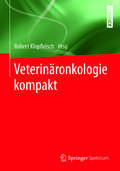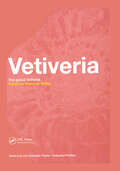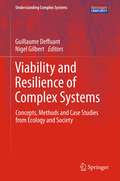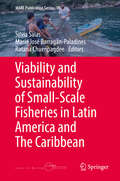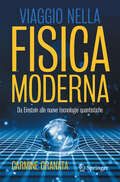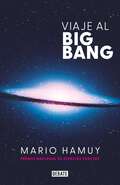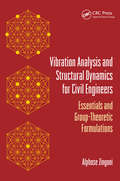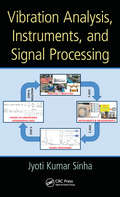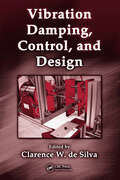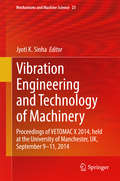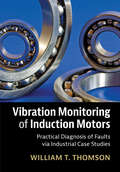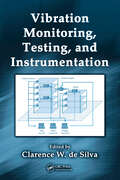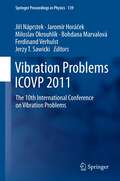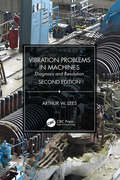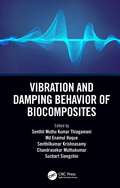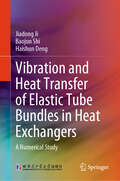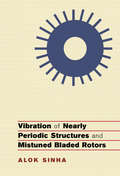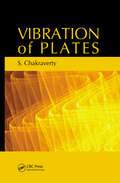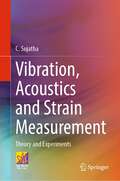- Table View
- List View
Veterinäronkologie kompakt
by Robert KlopfleischDas Buch gibt einen umfassenden und prägnanten Überblick über die grundsätzlichen Mechanismen der Tumorentstehung, diskutiert die relevantesten Tumoren der Haustiere im Detail und adressiert die Herangehensweise an die Tumordiagnose und -therapie. Die Kapitel enthalten zahlreiche makroskopische, histologische und zytologische Abbildungen zum besseren Verständnis der vermittelten Inhalte und stellt deshalb eine praktische Alternative zur ausschweifenden Spezialliteratur dar.Die Onkologie spielt sowohl als Lehrgebiet im Tiermedizinstudium als auch im täglichen Praxisleben des Tierarztes eine zunehmend wichtige Rolle. Veterinäronkologie kompakt richtet sich deshalb als umfassendes und gleichzeitig aber kurz gefasstes Nachschlagwerk sowohl an Tiermedizinstudenten als auch an den klinisch tätigen Tierarzt, der als Nichtspezialist einen schnellen Überblick und die wichtigsten Fakten zu einer spezifischen Tumorart benötigt.
Vetiveria: The Genus Vetiveria
by Massimo MaffeiVetiveria is one of the most versatile genera in plant kingdom. For example, the species Vetiveria zizanoides produces oderous roots from which a precious essential oil is distilled and used in a variety of applications from perfumery to ethnopharmacology. The same roots give the plant particular characteristics that make it a valuable natural barr
Viability and Resilience of Complex Systems
by Nigel Gilbert Guillaume DeffuantOne common characteristics of a complex system is its ability to withstand major disturbances and the capacity to rebuild itself. Understanding how such systems demonstrate resilience by absorbing or recovering from major external perturbations requires both quantitative foundations and a multidisciplinary view on the topic. This book demonstrates how new methods can be used to identify the actions favouring the recovery from perturbations. Examples discussed include bacterial biofilms resisting detachment, grassland savannahs recovering from fire, the dynamics of language competition and Internet social networking sites overcoming vandalism. The reader is taken through an introduction to the idea of resilience and viability and shown the mathematical basis of the techniques used to analyse systems. The idea of individual or agent-based modelling of complex systems is introduced and related to analytically tractable approximations of such models. A set of case studies illustrates the use of the techniques in real applications, and the final section describes how one can use new and elaborate software tools for carrying out the necessary calculations. The book is intended for a general scientific audience of readers from the natural and social sciences, yet requires some mathematics to gain a full understanding of the more theoretical chapters. It is an essential point of reference for those interested in the practical application of the concepts of resilience and viability
Viability and Sustainability of Small-Scale Fisheries in Latin America and The Caribbean (MARE Publication Series #19)
by Ratana Chuenpagdee María José Barragán-Paladines Silvia SalasOne of the main goals in fisheries governance is to promote viability and sustainability in small-scale fishing communities. This is not an easy task given external and internal pressure, including environmental change and competition with other economic sectors searching for development in the coastal region. A comprehensive understanding of small-scale fisheries in their own context, and from a regional perspective, is an important step in supporting the implementation of the Voluntary Guidelines on Securing Sustainable Small-Scale Fisheries (SSF Guidelines). This book contributes to the global effort by offering knowledge, insights and lessons about small-scale fisheries in Latin America and the Caribbean. The 20 case studies included in the book make explicit the various dimensions that are intrinsic to small-scale fisheries in the region, and identify conditions and situations that affect the wellbeing of fishing communities. The book offers insights regarding the challenges faced by small-scale fisheries in the region, and, aligning with the objectives of the SSF Guidelines, provides lessons and experiences about how to make small-scale fishing communities viable while maintaining sustainable fisheries. This important book illustrates the complexity, diversity, and dynamics of small-scale fisheries in the Latin American and Caribbean region and presents experiences, tools, and approaches to lead towards sustainable and viable fisheries. The reader will gain a new understanding on the range of actions, approaches, and information needed for their successful management. John F. Caddy, International Fisheries ExpertThis book, prepared by the Too Big To Ignore partnership, constitutes a very valuable resource for policy makers, fisheries scientists, non-governmental organizations, civil society organizations, and fishing communities interested in putting in place sound management strategies, research, and actions to contribute to the sustainability of small-scale fisheries and food security in Latin America and the Caribbean region. Juan Carlos Seijo, Professor of Fisheries Bioeconomics at Marist University of Merida
Viaggio nella fisica moderna: Da Einstein alle nuove tecnologie quantistiche
by Carmine GranataIl libro offre un breve viaggio nel sorprendente e spettacolare mondo della fisica moderna caratterizzato da idee e teorie dirompenti sia dal punto di vista concettuale che applicativo. Partendo dalla teoria della relatività di Einstein in cui i concetti di spazio, tempo e gravità vengono completamente rivisti, si arriva al bizzarro e affascinante universo della fisica quantistica che con le sue applicazioni ha cambiato completamente il nostro modo di vivere. Particolare attenzione è inoltre rivolta ai fondamenti concettuali e ai paradossi della meccanica quantistica grazie ai quali si è sviluppata in tempi più recenti la cosiddetta seconda rivoluzione quantistica, destinata a introdurre nelle nostre vite una nuova generazione di tecnologie quantistiche come computer, crittografia e teletrasporto. Oltre alle nuove tecnologie quantistiche, vengono illustrati in modo semplice e conciso i principi di funzionamento delle più importanti applicazioni della meccanica quantistica che si sono diffuse nella vita quotidiana. Il libro ha un carattere essenzialmente informativo, senza ricorrere a formule complicate o tecnicismi, pertanto non richiede conoscenze approfondite di fisica o matematica; le conoscenze acquisite nella scuola superiore sono sufficienti per comprendere gli argomenti trattati.
Viaje al Big Bang
by Mario HamuyEl destacado premio nacional de ciencias exactas nos explica la génesis y posterior evolución del universo. «¿Cómo es posible que, en mucho menos de un segundo, una explosión haya dado el puntapié inicial y fijado las leyes que regirían todo lo que vendría?» Esta, una de las preguntas más inquietantes elaboradas por la comunidad científica durante el siglo XX, es la que el prestigioso académico y divulgador científico Mario Hamuy intenta responder en este notable ensayo. Los astrónomos, de forma increíble, han logrado remontarse catorce mil millones de años al pasado y adentrarse en ese dramático segundo en el que se forjaron las condiciones iniciales de nuestro universo, nos asegura el autor de El sol negro. Desde allí, a partir de las propias leyes universales que el Big Bang se dio, se ha podido reconstruir su biografía y, de paso, la nuestra. Es así como hoy tenemos el privilegio de ser testigos de este momento clave de la humanidad, en el cual, por primera vez luego de muchos milenios contemplando e interrogando al cielo, nuestra especie puede comenzar a responder científicamente la pregunta ¿de dónde venimos los humanos?
Viaje de un naturalista alrededor del mundo
by Charles DarwinEste libro recoge las impresiones sobre las nuevas tierras que Darwin conoció en su expedición por América del Sur, Australia y las Islas Galápagos y que le llevaron a escribir El origen de las especies. En este diario, Darwin se muestra curioso y atento a la naturaleza, describiendo numerosos animales y plantas desconocidas hasta el momento. Charles Robert Darwin nació en Shrewsbury en 1809 y murió en Down en 1882. Participó en la expedición del Beagle por América del Sur, Australia y las Islas Galápagos.
Viajes a medianoche: Viajes al misterioso mundo del sueño (¡Arriba la Lectura! Level S #21)
by Maureen MecozziNIMAC-sourced textbook <p><p> Emprende un viaje de medianoche al misterioso mundo del sueño. Aprende cómo dormimos los seres humanos y cómo duermen los animales. Completa un test para averiguar si eres un búho nocturno o una alondra madrugadora.
Vibration Analysis and Structural Dynamics for Civil Engineers: Essentials and Group-Theoretic Formulations
by Alphose ZingoniAppeals to the Student and the Seasoned ProfessionalWhile the analysis of a civil-engineering structure typically seeks to quantify static effects (stresses and strains), there are some aspects that require considerations of vibration and dynamic behavior. Vibration Analysis and Structural Dynamics for Civil Engineers: Essentials and Group-Theoretic Formulations is relevant to instances that involve significant time-varying effects, including impact and sudden movement. It explains the basic theory to undergraduate and graduate students taking courses on vibration and dynamics, and also presents an original approach for the vibration analysis of symmetric systems, for both researchers and practicing engineers. Divided into two parts, it first covers the fundamentals of the vibration of engineering systems, and later addresses how symmetry affects vibration behavior.Part I treats the modeling of discrete single and multi-degree-of-freedom systems, as well as mathematical formulations for continuous systems, both analytical and numerical. It also features some worked examples and tutorial problems. Part II introduces the mathematical concepts of group theory and symmetry groups, and applies these to the vibration of a diverse range of problems in structural mechanics. It reveals the computational benefits of the group-theoretic approach, and sheds new insights on complex vibration phenomena.The book consists of 11 chapters with topics that include: The vibration of discrete systems or lumped parameter models The free and forced response of single degree-of-freedom systems The vibration of systems with multiple degrees of freedom The vibration of continuous systems (strings, rods and beams) The essentials of finite-element vibration modelling Symmetry considerations and an outline of group and representation theories Applications of group theory to the vibration of linear mechanical systems Applications of group theory to the vibration of structural grids and cable nets Group-theoretic finite-element and finite-difference formulations Vibration Analysis and Structural Dynamics for Civil Engineers: Essentials and Group-Theoretic Formulations acquaints students with the fundamentals of vibration theory, informs experienced structural practitioners on simple and effective techniques for vibration modelling, and provides researchers with new directions for the development of computational vibration procedures.
Vibration Analysis, Instruments, and Signal Processing
by Jyoti Kumar SinhaProvides Typical Abstract Representations of Different Steps for Analyzing Any Dynamic SystemVibration and dynamics are common in everyday life, and the use of vibration measurements, tests, and analyses is becoming standard for various applications. Vibration Analysis, Instruments, and Signal Processing focuses on the basic understanding of vibrat
Vibration Assisted Machining: Theory, Modelling and Applications (Wiley-ASME Press Series)
by Dehong Huo Lu Zheng Wanqun ChenThe first book to comprehensively address the theory, kinematic modelling, numerical simulation and applications of vibration assisted machining Vibration Assisted Machining: Theory, Modelling and Applications covers all key aspects of vibration assisted machining, including cutting kinematics and dynamics, the effect of workpiece materials and wear of cutting tools. It also addresses practical applications for these techniques. Case studies provide detailed guidance on the design, modeling and testing of VAM systems. Experimental machining methods are also included, alongside considerations of state-of-the-art research developments on cutting force modeling and surface texture generation. Advances in computational modelling, surface metrology and manufacturing science over the past few decades have led to tremendous benefits for industry. This is the first comprehensive book dedicated to design, modelling, simulation and integration of vibration assisted machining system and processes, enabling wider industrial application of the technology. This book enables engineering students and professionals in manufacturing to understand and implement the latest vibration assisted machining techniques. Highlights include: Comprehensive coverage of the theory, kinematics modelling, numerical simulation and applications of vibration assisted machining (VAM) Case studies with detailed guidance on design, modelling and testing of VAM systems, as well as experimental machining methods Discussion of state-of-the-art research developments on cutting force modelling and surface texture generation Coverage of the history of VAM, its current applications and future directions for the technology Vibration Assisted Machining: Theory, Modelling and Applications provides engineering students, researchers, manufacturing engineers, production supervisors, tooling engineers, planning and application engineers and machine tool designers with the fundamentals of vibration assisted machining, along with methodologies for developing and implementing the technology to solve practical industry problems.
Vibration Damping, Control, and Design
by Clarence W. de SilvaReducing and controlling the level of vibration in a mechanical system leads to an improved work environment and product quality, reduced noise, more economical operation, and longer equipment life. Adequate design is essential for reducing vibrations, while damping and control methods help further reduce and manipulate vibrations when design strat
Vibration Engineering and Technology of Machinery
by Jyoti K. SinhaThe VETOMAC-X Conference covered a holistic plethora of relevant topics in vibration and engineering technology including condition monitoring, machinery and structural dynamics, rotor dynamics, experimental techniques, finite element model updating, industrial case studies, vibration control and energy harvesting, and signal processing. These proceedings contain not only all of the nearly one-hundred peer-reviewed presentations from authors representing more than twenty countries, but also include six invited lectures from renowned experts: Professor K. Gupta, Mr W. Hahn, Professor A. W. Lees, Professor John Mottershead, Professor J. S. Rao, and Dr P. Russhard. This work is of interest to researchers and practitioners alike, and is an essential book for most of libraries of higher academic institutes.
Vibration Engineering and Technology of Machinery, Volume II: Select Proceedings of VETOMAC XVI 2021 (Mechanisms and Machine Science #153)
by Rajiv Tiwari V. Arun Kumar Y. S. Ram Mohan Ashish K. Darpe Mayank TiwariThis book presents the proceedings of the XVI International Conference on Vibration Engineering and Technology of Machinery (VETOMAC 2021). It gathers the latest advances, innovations, and applications in the field of vibration and technology of machinery. Topics include concepts and methods in dynamics, dynamics of mechanical and structural systems, dynamics and control, condition monitoring, machinery and structural dynamics, rotor dynamics, experimental techniques, finite element model updating, industrial case studies, vibration control and energy harvesting, and MEMS. The contributions, which were selected through a rigorous international peer-review process, share exciting ideas that will spur novel research directions and foster new multidisciplinary collaborations. The book is useful for the researchers, engineers and professionals working in the area of vibration engineering and technology of machinery.
Vibration Monitoring of Induction Motors: Practical Diagnosis of Faults via Industrial Case Studies
by William T. ThomsonMaster the art of vibration monitoring of induction motors with this unique guide to on-line condition assessment and fault diagnosis, building on the author's fifty years of investigative expertise. It includes: *Robust techniques for diagnosing of a wide range of common faults, including shaft misalignment and/or soft foot, rolling element bearing faults, sleeve bearing faults, magnetic and vibrational issues, resonance in vertical motor drives, and vibration and acoustic noise from inverters. *Detailed technical coverage of thirty real-world industrial case studies, from initial vibration spectrum analysis through to fault diagnosis and final strip-down. *An introduction to real-world vibration spectrum analysis for fault diagnosis, and practical guidelines to reduce bearing failure through effective grease management. This definitive book is essential reading for industrial end-users, engineers, and technicians working in motor design, manufacturing, and condition monitoring. It will also be of interest to researchers and graduate students working on condition monitoring.
Vibration Monitoring, Testing, and Instrumentation (Mechanical and Aerospace Engineering Series)
by Clarence W. de SilvaControlling a system's vibrational behavior, whether for reducing harmful vibrations or for enhancing useful types, is critical to ensure safe and economical operation as well as longer structural and equipment lifetimes. A related issue is the effect of vibration on humans and their environment. Achieving control of vibration requires thorough und
Vibration Problems ICOVP 2011
by Bohdana Marvalová Ferdinand Verhulst Jaromír Horáček Jerzy T. Sawicki Jiří Náprstek Miloslav OkrouhlíkThis volume presents the Proceedings of the 10th International Conference on Vibration Problems, 2011, Prague, Czech Republic. ICOVP 2011 brings together again scientists from different backgrounds who are actively working on vibration-related problems of engineering both in theoretical and applied fields, thus facilitating a lively exchange of ideas, methods and results between the many different research areas. The aim is that reciprocal intellectual fertilization will take place and ensure a broad interdisciplinary research field. The topics, indeed, cover a wide variety of vibration-related subjects, from wave problems in solid mechanics to vibration problems related to biomechanics. The first ICOVP conference was held in 1990 at A.C. College, Jalpaiguri, India, under the co-chairmanship of Professor M.M. Banerjee and Professor P. Biswas. Since then it has been held every 2 years at various venues across the World.
Vibration Problems in Machines: Diagnosis and Resolution
by Arthur W. LeesVibration Problems in Machines explains how to infer information about the internal operations of rotating machines from external measurements through methods used to resolve practical plant problems. Second edition includes summary of instrumentation, methods for establishing machine rundown data, relationship between the rundown curves and the ideal frequency response function. The section on balancing has been expanded and examples are given on the strategies for balancing a rotor with a bend, with new section on instabilities. It includes case studies with real plant data, MATLAB® scripts and functions for the modelling and analysis of rotating machines.
Vibration and Damping Behavior of Biocomposites
by Senthil Muthu Kumar ThiagamaniFiber-reinforced polymer composites exhibit better damping characteristics than conventional metals due to the viscoelastic nature of the polymers. There has been a growing interest among research communities and industries in the use of natural fibers as reinforcements in structural and semi-structural applications, given their environmental advantages. Knowledge of the vibration and damping behavior of biocomposites is essential for engineers and scientists who work in the field of composite materials. Vibration and Damping Behavior of Biocomposites brings together the latest research developments in vibration and viscoelastic behavior of composites filled with different natural fibers. Features: Reviews the effect of various types of reinforcements on free vibration behavior Emphasizes aging effects, influence of compatibilizers, and hybrid fiber reinforcement Explores the influence of resin type on viscoelastic properties Covers the use of computational modeling to analyze dynamic behavior and viscoelastic properties Discusses viscoelastic damping characterization through dynamic mechanical analysis. This compilation will greatly benefit academics, researchers, advanced students, and practicing engineers in materials and mechanical engineering and related fields who work with biocomposites. Editors Dr. Senthil Muthu Kumar Thiagamani, Kalasalinagam Academy of Research and Education (KARE), India Dr. Md Enamul Hoque, Military Institute of Science and Technology (MIST), Bangladesh Dr. Senthilkumar Krishnasamy, King Mongkut’s University of Technology North Bangkok KMUTNB, Thailand Dr. Chandrasekar Muthukumar, Hindustan Institute of Technology & Science (HITS), India Dr. Suchart Siengchin, King Mongkut’s University of Technology North Bangkok KMUTNB, Thailand
Vibration and Heat Transfer of Elastic Tube Bundles in Heat Exchangers: A Numerical Study
by Jiadong Ji Baojun Shi Haishun DengThis book systematically investigates the vibration and enhanced heat transfer of elastic tube bundles in heat exchangers. Using numerical calculation methods, it explores the working principles, optimization design, and performance enhancement of elastic tube bundle heat exchangers. The book presents research findings with clear illustrations and detailed analysis, allowing readers to gain a deep understanding and practical application of the subject. Whether from an academic research or engineering practice perspective, this book serves as a valuable reference and guide. It provides readers with insight and guidance on both theoretical and practical aspects of the field. With its comprehensive coverage and practical approach, this book is essential reading for researchers, engineers, and students interested in the vibration and heat transfer of elastic tube bundles in heat exchangers.
Vibration and Structural Acoustics Analysis
by J. Dias Rodrigues C.M.A. VasquesVibration and structural acoustics analysis has become an essential requirement for high-quality structural and mechanical design in order to assure acoustic comfort and the integrity, reliability and fail-safe behavior of structures and machines. The underlying technologies of this field of multidisciplinary research are evolving very fast and their dissemination is usually scattered over different and complementary scientific and technical publication means. In order to make it easy for developers and technology end-users to follow the latest developments and news in the field, this book collects into a single volume selected, extended, updated and revised versions of papers presented at the Symposium on Vibration and Structural Acoustics Analysis, coordinated by J. Dias Rodrigues and C. M. A. Vasques, which was organised as part of the 3rd International Conference on Integrity, Reliability & Failure (IRF'2009), co-chaired by J. F. Silva Gomes and Shaker A. Meguid, held at the Faculty of Engineering of the University of Porto, Portugal, 20-24 July 2009. These papers where chosen from the more than 60 papers presented at the conference symposium. Written by experienced practitioners and researchers in the field, this book brings together recent developments in the field, spanning across a broad range of themes: vibration analysis, analytical and computational structural acoustics and vibration, material systems and technologies for noise and vibration control, vibration-based structural health monitoring/evaluation, machinery noise/vibration and diagnostics, experimental testing in vibration and structural acoustics, applications and case studies in structural acoustics and vibration. Each chapter presents and describes the state of the art, presents current research results and discusses the need for future developments in a particular aspect of vibration and structural acoustics analysis. The book is envisaged to be an appealing text for newcomers to the subject and a useful research study tool for advanced students and faculty members. Practitioners and researchers may also find this book a one-stop reference that addresses current and future challenges in this field. The variety of case studies is expected to stimulate a holistic view of sound and vibration and related fields and to appeal to a broad spectrum of engineers such as the ones in the mechanical, aeronautical, aerospace, civil and electrical communities.
Vibration of Mechanical Systems
by Alok SinhaIn this textbook all the basic concepts in mechanical vibrations are clearly identified and presented in a concise and simple manner with illustrative and practical examples. Vibration concepts include a review of selected topics in mechanics; a description of single-degree-of-freedom (SDOF) systems in terms of equivalent mass, equivalent stiffness, and equivalent damping; a unified treatment of various forced response problems (base excitation and rotating balance); an introduction to systems thinking, highlighting the fact that SDOF analysis is a building block for multi-degree-of-freedom (MDOF) and continuous system analyses via modal analysis; and a simple introduction to finite element analysis to connect continuous system and MDOF analyses. There are more than 60 exercise problems, and a complete solutions manual. The use of MATLAB-AE software is emphasised
Vibration of Nearly Periodic Structures and Mistuned Bladed Rotors
by Alok SinhaThis is the first comprehensive volume on nearly periodic structures and mistuned blade vibration. Alok Sinha presents fundamental concepts and state-of-the-art techniques in the analysis of free and forced response of a nearly periodic structure, weaving together his own work (covering thirty-five years of research in this field) with works by other researchers. He also discusses similarities between tools used in bladed rotor analysis and condensed matter physics. Specific subjects covered include the reasons behind mode localization, the reasons behind amplitude amplification of steady-state response, state-of-the-art computational techniques for mistuned bladed rotors including multistage rotors, identification of mistuning from measured response, vibration localization in linear atomic chains, and analysis of two-dimensional periodic structures.
Vibration of Plates
by Snehashish ChakravertyPlates are integral parts of most engineering structures and their vibration analysis is required for safe design. Vibration of Plates provides a comprehensive, self-contained introduction to vibration theory and analysis of two-dimensional plates. Reflecting the author's more than 15 years of original research on plate vibration, this book present
Vibration, Acoustics and Strain Measurement: Theory and Experiments
by C. SujathaThis textbook provides a comprehensive description of a variety of vibration and acoustic pickups and exciters, as well as strain gauge transducers. It is an exhaustive manual for setting up basic and involved experiments in the areas of vibration, acoustics and strain measurement (using strain gauges only). It further serves as a reference to conduct experiments of a pedagogical nature in these areas. It covers the various theoretical aspects of experimental test rigs, as well as a description and choice of transducers/equipment. The fundamentals of signal processing theory, including the basics of random signals, have been included to enable the user to make a proper choice of settings on an analyser or measuring equipment. Also added is a description of modal analysis theory and related parameter extraction techniques. All chapters are provided with conceptual questions which will provoke the reader to think and gain a better understanding of the subjects. The textbook illustrates around fifty experiments in the areas of vibration, acoustics and strain measurements. Given the contents, this textbook is useful for undergraduate and postgraduate students in the areas of mechanical engineering, with applications that range from civil structures, architectural and environmental systems, and all forms of mechanical systems including transport vehicles and aircraft.
